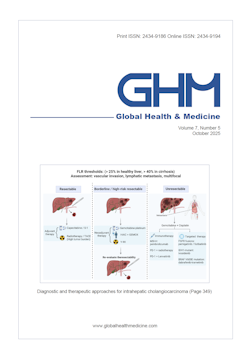Global Health & Medicine 2024;6(2):108-116.
Knowledge, attitudes, practices and prevalence of hepatitis B and C and hepatitis B vaccination coverage among public sector healthcare workers in Cambodia
By Y, Le LV, Suy S, Chou M, Chan PL, Heng K, Phou S, Ny C, Deng S, Phoeung CL, Mam S, Ferradini L, Babin FX, Saphonn V
Healthcare workers (HCWs) are a key population at high risk for hepatitis B (HBV) and hepatitis C (HCV) infections. We aim to study HBV vaccination coverage, seroprevalence, knowledge, attitudes, and practices towards HBV and HCV infections among HCWs in public sector in Cambodia. A nationally representative crosssectional study was implemented in 2019, among Cambodian HCWs. A standardized questionnaire was administered to randomly selected HCWs whose blood was then sampled. We used univariate and multivariate regression to determine predictors of outcomes. Among 755 participants, we found 4.9% positive HBsAg and 2.3% positive anti-HCV Ab. HBV vaccination coverage was 59.3%. Lack of knowledge was found on the route of transmission, HBV vaccination, diagnosis and treatment of HBV and HCV. 67% of HCWs thought that all patients should be screened for HBV and HCV and about 30% of them would refuse to take care of infected patients. 58% of HCWs always recapped the needle after use. In univariate analysis, older age-group (> 50 years) is more likely to have positive anti-HCV (OR: 9.48; 95% CI: 2.36–38.18). HCWs who were younger, female or having higher education or having ever been tested, were more likely to have gotten HBV vaccinated. Multivariate analysis reconfirmed these predictors of getting vaccinated. Study findings indicated an urgent need of a national policy for Cambodian HCWs given the high prevalence of hepatitis among this group. Policy should include an effective in-service training program to improve knowledge and practices, a testing and vaccination program for HCWs and it should emphasize stigma intervention towards people living with HBV/HCV.
DOI: 10.35772/ghm.2023.01097







